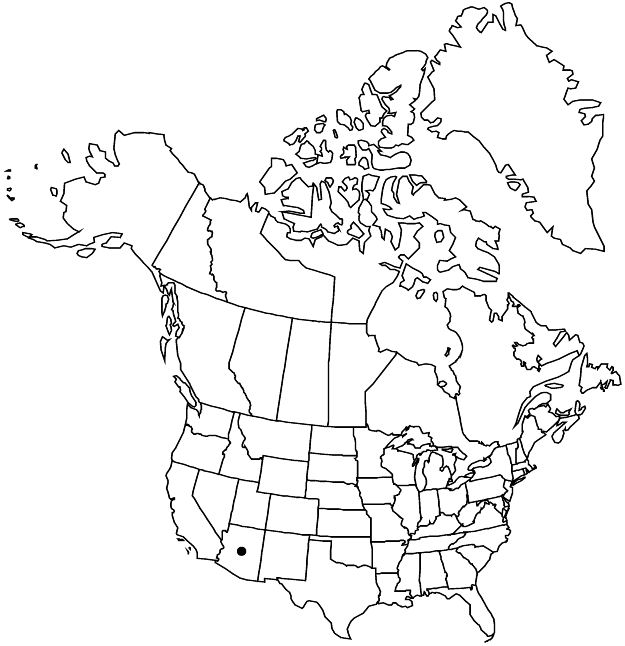Difference between revisions of "Euphorbia macropus"
Prodr. 15(2): 52. 1862.
FNA>Volume Importer |
FNA>Volume Importer |
||
| Line 15: | Line 15: | ||
|name=Euphorbia biformis | |name=Euphorbia biformis | ||
|authority=S. Watson | |authority=S. Watson | ||
| − | }}{{Treatment/ID/Synonym | + | }} {{Treatment/ID/Synonym |
|name=E. plummerae | |name=E. plummerae | ||
|authority=S. Watson | |authority=S. Watson | ||
| Line 33: | Line 33: | ||
|elevation=1500–2200m. | |elevation=1500–2200m. | ||
|distribution=Ariz.;Mexico;Central America (Guatemala;Honduras). | |distribution=Ariz.;Mexico;Central America (Guatemala;Honduras). | ||
| − | |discussion=<p>Euphorbia macropus is a widespread and common Mexican species just barely entering the flora area in southeastern Arizona, where most of the collections are from the Huachuca Mountains.</p> | + | |discussion=<p><i>Euphorbia macropus</i> is a widespread and common Mexican species just barely entering the flora area in southeastern Arizona, where most of the collections are from the Huachuca Mountains.</p> |
|tables= | |tables= | ||
|references= | |references= | ||
| Line 57: | Line 57: | ||
|publication year=1862 | |publication year=1862 | ||
|special status= | |special status= | ||
| − | |source xml=https://jpend@bitbucket.org/aafc-mbb/fna-data-curation.git/src/ | + | |source xml=https://jpend@bitbucket.org/aafc-mbb/fna-data-curation.git/src/8f726806613d60c220dc4493de13607dd3150896/coarse_grained_fna_xml/V12/V12_741.xml |
|genus=Euphorbia | |genus=Euphorbia | ||
|section=Euphorbia sect. Alectoroctonum | |section=Euphorbia sect. Alectoroctonum | ||
Revision as of 14:49, 18 September 2019
Herbs, perennial, with thick, globose to elongated tubers, 2–8 cm. Stems erect to ascending, branched, 10–45(–60) cm, glabrous, puberulent, or densely hirsute to setose, often with 2-layered indumentum of long hairs intermixed with short hairs. Leaves usually opposite, occasionally whorled distally, or rarely with 1–2 alternate leaves; stipules 0.1–0.2 mm; petiole 0–18 mm, hirsute, sericeous, or strigose; blade linear to ovate or almost orbiculate, 6–54 × 2–19 mm, base rounded to attenuate, margins entire, occasionally ciliate with stiff recurved hairs, apex acute to obtuse, surfaces usually hirsute, sericeous, or strigose, occasionally glabrous adaxially; venation conspicuous. Cyathia in weakly-defined terminal dichasia; peduncle 1.4–5.8 mm, glabrous. Involucre obconic to campanulate, 1.1–1.4 × 0.5–1.5 mm, glabrous or strigillose; glands 4–5, greenish, oblong, 0.2 × 0.4–0.5 mm; appendages usually yellowish or green, rarely dark purple, ovate, flabellate, semiorbiculate, or oblong, 0.3–0.9 × 0.4–1.1 mm, usually entire. Staminate flowers 10–15. Pistillate flowers: ovary glabrous, sericeous, or strigillose; styles 0.4–0.6 mm, 2-fid 1/2 length. Capsules oblate, 2.3–3 × 3.1–4.2 mm, glabrous, sericeous, or strigillose; columella 1.6–2.1 mm. Seeds black to light brown, broadly ovoid to subglobose, rounded in cross section, 1.5–2.3 × 1.4–1.8 mm, smooth or with low rounded tubercles; caruncle absent.
Phenology: Flowering and fruiting summer–fall.
Habitat: Stream banks and rocky slopes in pine-oak woodlands, sometimes with juniper, Douglas fir-pine forests.
Elevation: 1500–2200m.
Distribution

Ariz., Mexico, Central America (Guatemala, Honduras).
Discussion
Euphorbia macropus is a widespread and common Mexican species just barely entering the flora area in southeastern Arizona, where most of the collections are from the Huachuca Mountains.
Selected References
None.